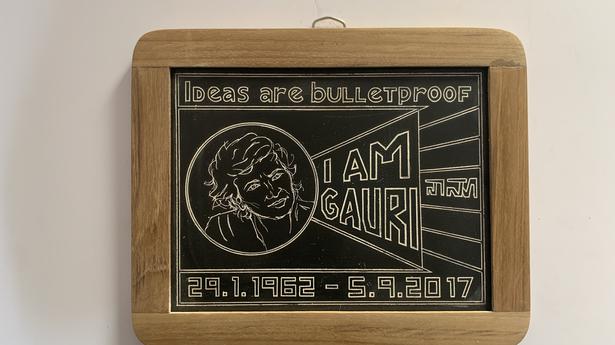
Epigraphica Indica: Showcasing the power of the written word
The Hindu
‘Epigraphica Indica,’ a solo show by Pushpamala N, is currently underway at Gallery Sumukha in Bengaluru
In ‘Epigraphica Indica,’ Bengaluru-based artist Pushpamala N displays how the written word wields its power in everyday life. Two sets of exhibits are part of the show — ‘Atlas of Rare and Lost Alphabets’ and ‘Nara’ (slogans).
“Epigraphy is the study and interpretation of ancient inscriptions on metal or stone. That is why the show is called Epigraphica Indica. I was always interested in documents, and various aspects of history have been ingrained in my work from the very beginning,” says Pushpamala, who has regularly used 19th-century concepts of ethnography, anthropology and archiving, in her previous works.
The ‘Atlas of Rare and Lost Alphabets’ are a set of a hundred copperplate sculptures inspired by the artist’s visit to an archaeological museum in Bengaluru. Pushpamala says ‘Atlas’, like a lot of her other works, was inspired by Walter Benjamin’s Arcade Project, one of her favourite books. “He looked at the present as a ruin and examined it like an archaeologist.”
In ancient India, important documents such as land deeds and official edicts were etched on copperplates and were called tamra shasanas (copper edicts). Pushpamala decided to recreate them using the technique of etching and over three years from 2015 to 18, inscribed copperplates with various scripts of the Indian sub-continent by hand. She worked with different chemicals to create a patina and as a result, each plate looks as though it was unearthed at a historic site.
“Though the process of writing and drawing was tedious, I enjoyed it as it was very different from my usual rhythm of working with photographs, videos and live performances,” she says.
While researching for this project, Pushpamala found out there was a worldwide movement dedicated to preserving and documenting scripts that were disappearing. “There were older forms of Kannada and Tamil; Tulu — always thought to be an oral language — once had a written script which fell into disuse during colonial times. Assamese too had a script, but now uses Bengali. At the same time, people are also working to create scripts such as Kodava. The Phags-pa alphabet created by a Chinese monk during the Yuan dynasty was written from top to bottom. It had the appearance of Indian letters, but never really took off and only a few examples of the script remain,” she says.
Pushpamala elaborates that the subcontinent — India, Sri Lanka, the Maldives, Tibet, Afghanistan — is home to hundreds of scripts. “I doubt there is such diversity elsewhere,” she says, adding, “There is also a political side to this issue as communities which only have an oral language feel deprived of identity, prestige and a recorded history of their being. Though their literature might use some other script, they feel the need for a specific script of their own.”











